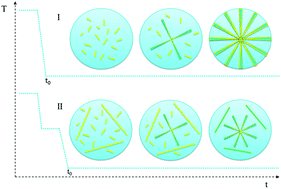Pathway mediated microstructures and phase morphologies of asymmetric double crystalline co-oligomers
Abstract
Various microstructures and phase morphologies of an amphiphilic poly(ethylene oxide)-block-polyethylene (PEO-b-PE) co-oligomer, controlled by topological restriction of PE segments on the tethered PEO chains, were characterized by differential scanning calorimetry (DSC), polarized optical microscopy (POM), scanning electron microscopy (SEM), and synchrotron radiation wide-angle/small-angle X-ray scattering (WAXS/SAXS) in drop-cast films. The crystallization processes were mediated by two pathways, a one-step crystallization process (I) and a sequential crystallization process (II). Results show that the thermal procedures have great influence on the microstructures and phase morphologies of PEO-b-PE co-oligomer, e.g., negative spherulites with radial stripes were detected in the one-step crystallization process (I), while crystalline texture, which contains a large number of crystals with reduced sizes, formed in the sequential crystallization process (II). Based on our experimental data, the topological restriction effect encountered by PEO chains depends on the hard confinement of PE crystals and the soft confinement of amorphous PE in the two crystallization procedures. The formation mechanisms of the long-range order structures within the co-oligomer were elucidated through morphology models. These nano-patterned structures make the double crystalline block copolymers outstanding candidates for surface modification, micromolding, and optoelectronic devices in nanotechnological and biomedical applications.


 Please wait while we load your content...
Please wait while we load your content...